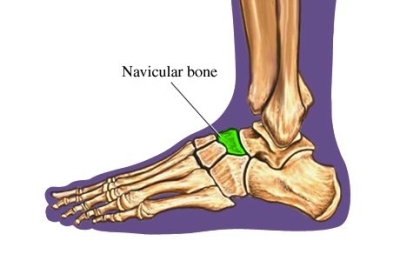
Posted in Rehabilitation, Running.
So You Rolled Your Ankle … Now What?
by Morgan Mowers, PT, DPT, FAFS
Ahhh, one of the most frustrating of all running injuries…. The rolled ankle.
I know because I’ve been there—just a few weeks ago, I was finally feeling like I was getting back into shape, finding my groove in a good training program. Then, I was out for an eight mile run in Rock Creek Park in DC when I dodged a cyclist and my ankle gave out, feeling an audible CRACK as I fell to the ground.
So, what should you do if you roll your ankle on a run?
First and foremost, assess how severe it is. If you have bony tenderness at your middle / outer ankle, fifth toe, or navicular bone (see photo), and/or cannot stand on that leg or take four steps forward, get to urgent care ASAP to rule out a fracture.
If you’re able to walk on that leg, the first thing is to get home and reduce or prevent swelling. Elevate your foot and perform small motions in each direction– only within a pain-free range of motion (see video). You may alternate between ice and heat for short periods of time (10 minutes of ice to 10 minutes of heat OR if you don’t have a heat pack just remove the ice for 10 minutes at a time) and elevate your foot. Keep performing that small controlled range of motion while the ice is on. Icing for too long can restrict blood flow to the area which will delay healing, so keep the sessions short. Wearing a gentle compression sleeve or sock is also a great idea.
Return to running may vary based on severity.
A grade I sprain results in minimal pain and minor swelling which may only last for 1-3 days. Grade II is a slightly more severe small tear, and you may experience worse swelling, potential bruising, with pain in weight bearing, but you will likely still be able to walk. A grade III tear is a full ligament tear, resulting in severe instability. This means difficulty walking without your ankle giving out. If you suspect a grade III tear, it’s best to go to the orthopedist or podiatrist to discuss treatment, which MAY involve immobilizing your ankle.
In the case of a grade I or II sprain, it’s foremost important to be sure a majority of the swelling in your ankle is gone.
Beyond that, can you do these three things pain free:
- Walking
- Skipping
- Single leg heel raises (30)
- Single leg hopping (10)
- Single leg squats (5)
Once you can, then it is safe to say you are clear to run, but it’s important to consider doing specific ankle strengthening exercises. If you’re not so sure, talk to your PT prior to getting back at it.
Regardless of severity, it’s always best to see a physio after an ankle sprain to help you reduce swelling, increase strength and stability, and to prevent further injury or tissue damage.
